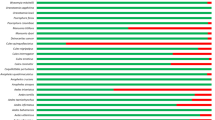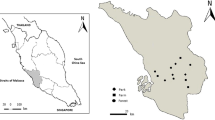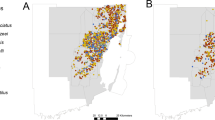Abstract
We aimed to determine how the degree of urbanization in a Neotropical city influences Aedes aegypti (L.), a pantropical vector of urban yellow fever, dengue, Zika and Chikungunia, via other mosquito species, whether they are competitors or predators, native to the area or invasive. We conducted experiments twice a month during one year in the city of Kourou, French Guiana, on three sites characterized by increasing percentages of imperviousness (i.e., 0.65%, 33.80% and 86.60%). These sites were located in a ≈5 ha forest fragment, a residential area with gardens, and in the older part of the city, respectively, and correspond to slightly, moderately and highly urbanized sites. There, we monitored twice a month during one year a total of 108 mosquito communities inhabiting four types of containers (i.e., a tank bromeliad, dry stumps of bamboo, ovitraps and car tires) installed in a random block design. In the tanks of the bromeliad, likely due to the acidity of the water, the immatures of native mosquito species prevailed, particularly Wyeomyia pertinans (Williston) in the slightly urbanized site. The general pattern was very similar in the three other types of containers where Limatus durhamii Théobald dominated in the slightly urbanized site, so that the abundance of Ae. aegypti immatures was low compared to those of native species. Yet, Ae. aegypti strongly dominated in the two more urbanized sites. These findings open up perspectives for vector management, including the conservation and/or the augmentation of natural enemies through modifications to landscape features.




Similar content being viewed by others
References
Adhikari K, Khanikor B, Sarma R (2022) Persistent susceptibility of Aedes aegypti to eugenol. Sci Rep 12:2277. https://doi.org/10.1038/s41598-022-06302-8
Ahmad D, Sumra MW, Shah RM, Alam M, Shad SA, Naeem-Ullah U, Binyameen M (2022) Effects of interspecific competition between Aedes aegypti and Culex quinquefasciatus on their life history traits. Int J Trop Insect Sci 42:629–635. https://doi.org/10.1007/s42690-021-00582-9
Alford RA, Wilbur HM (1985) Priority effects in experimental pond communities: competition between Bufo and Rana. Ecology 66:1097–1105. https://doi.org/10.2307/1939161
Barrera B (2022) New tools for Aedes control: mass trapping. Curr Opin Insect Sci 52:100942. https://doi.org/10.1016/j.cois.2022.100942
Bastos AQ, Leite PJ, de Mello CF, Maia DA, Machado SL, Gil-Santana HR et al (2021) Bionomy of mosquitoes in bamboo internodes in an Atlantic forest remnant of the state of Rio De Janeiro, Brazil. J Am Mosq Control Assoc 37:208–215. https://doi.org/10.2987/21-7044
Bennett KL, Martínez CG, Almanza A, Rovira JR, McMillan WO, Enriquez V et al (2019) High infestation of invasive Aedes mosquitoes in used tires along the local transport network of Panama. Parasit Vectors 12:264. https://doi.org/10.1186/s13071-019-3522-8
Bhattacharya S, Basu P (2016) The Southern house mosquito, Culex quinquefasciatus: profile of a smart vector. J Entomol Zool Stud 4:73–81
Blaustein L, Chase JM (2007) Interactions between mosquito larvae and species that share the same trophic level. Annu Rev Entomol 52:489–507. https://doi.org/10.1146/annurev.ento.52.110405.091431
Boullis A, Mulatier M, Delannay C, Hery L, Verheggen JF, Vega-Rúa A (2021) Behavioural and antennal responses of Aedes aegypti (L.) (Diptera: Culicidae) gravid females to chemical cues from conspecific larvae. PLoS ONE 16:e0247657. https://doi.org/10.1371/journal.pone.0247657
Ceretti-Júnior W, Medeiros-Sousa AR, Multini LC, Urbinatti PR, Vendrami DP, Natal D et al (2014) Immature mosquitoes in bamboo internodes in municipal parks, city of São Paulo, Brazil. J Am Mosq Control Assoc 30:268–274. https://doi.org/10.2987/14-6403R.1
Chen J, Luoa J, Wanga Y, Gurava AS, Lic M, Akbaric OS, Montell C (2021) Suppression of female fertility in Aedes aegypti with a CRISPR-targeted male-sterile mutation. PNAS 118:e2105075118. https://doi.org/10.1073/pnas.2105075118
Couper LI, Farner JE, Caldwell JM, Childs ML, Harris MJ, Kirk DG et al (2021) How will mosquitoes adapt to climate warming? eLife 10:e69630. https://doi.org/10.7554/eLife.69630
da Silva RM, Vital WO, da Fonseca RN, Martins YPM, Lemos FJA, da Silva Vaz Jr I et al (2019) Hypometabolic strategy and glucose metabolism maintenance of Aedes aegypti egg desiccation. Comp Biochem Physiol B Biochem Mol Biol 227:56–63. https://doi.org/10.1016/j.cbpb.2018.09.005
Diamond SE, Martin RA (2021) Evolution in cities. Annu Rev Ecol Evol Syst 52:519–540. https://doi.org/10.1146/annurev-ecolsys-012021-021402
Flaibani N, Pérez AA, Barbero IM, Burroni NE (2020) Different approaches to characterize artificial breeding sites of Aedes aegypti using generalized linear mixed models. Infect Dis Poverty 9:107. https://doi.org/10.1186/s40249-020-00705-3
Focks D (2007) Toxorhynchites as biocontrol agent. J Am Mosq Control Assoc 33:118–127. https://doi.org/10.3390/insects11110747
Honório NA, Silva WDC, Leite PJ, Gonçalves JM, Lounibos LP, Lourenço-de-Oliveira R (2003) Dispersal of Aedes aegypti and Aedes albopictus (Diptera: Culicidae) in an urban endemic dengue area in the State of Rio de Janeiro, Brazil. Mem Instit Oswaldo Cruz 98:191–198. https://doi.org/10.1590/s0074-02762003000200005
Juliano SA (2009) Species interactions among larval mosquitoes: context dependence across habitat gradients. Annu Rev Entomol 54:37–56. https://doi.org/10.1146/annurev.ento.54.110807.090611
Kolimenakis A, Heinz S, Wilson ML, Winkler V, Yakob L, Michaelakis A et al (2021) The role of urbanisation in the spread of Aedes mosquitoes and the diseases they transmit - A systematic review. PLoS Negl Trop Dis 15:e0009631. https://doi.org/10.1371/journal.pntd.0009631
Lahondère C, Bonizzoni M (2022) Thermal biology of invasive Aedes mosquitoes in the context of climate change. Curr Opin Insect Sci 51:100920. https://doi.org/10.1016/j.cois.2022.100920
Lane J (1953) Neotropical Culicidae. Vol. I and II. Universidade de São Paulo, São Paulo, p 1112
Lopez LC, Silva EG, Beltrão MG, Leandro RS, Barbosa JE, Beserra EB (2011) Effect of tank bromeliad micro-environment on Aedes aegypti larval mortality. Hydrobiologia 665:257–261. https://doi.org/10.1007/s10750-011-0605-8
Lounibos LP (2007) Competitive displacement and reduction. J Am Mosq Control Assoc 23:276–282. https://doi.org/10.2987/8756-971x(2007)23[276:cdar]2.0.co;2
Maneerat S, Daudé E (2016) A spatial agent-based simulation model of the dengue vector Aedes aegypti to explore its population dynamics in urban areas. Ecol Model 333:66–78. https://doi.org/10.1016/j.ecolmodel.2016.04.012
Martín-Park A, Che-Mendoza A, Contreras-Perera Y, Pérez-Carrillo S, Puerta-Guardo H, Villegas-Chim J et al (2022) Pilot trial using mass field-releases of sterile males produced with the incompatible and sterile insect techniques as part of integrated Aedes aegypti control in Mexico. PLoS Negl Trop Dis 16:e0010324. https://doi.org/10.1371/journal.pntd.0010324
Mocellin MG, Simões TC, do Nascimento TFS, Teixeira MLF, Lounibos LP, Lourenço de Oliveira R (2009) Bromeliad-inhabiting mosquitoes in an urban botanical garden of dengue endemic Rio de Janeiro Are bromeliads productive habitats for the invasive vectors Aedes aegypti and Aedes albopictus? Mem Inst Oswaldo Cruz 104:1171–1176. https://doi.org/10.1590/s0074-02762009000800015
Mohajerani A, Bakaric J, Jeffrey-Bailey T (2017) The urban heat island effect, its causes, and mitigation, with reference to the thermal properties of asphalt concrete. J Environ Manag 197:522–538. https://doi.org/10.1016/j.jenvman.2017.03.095
Mulatier M, Boullis A, Vega-Rúa A (2022) Semiochemical oviposition cues to control Aedes aegypti gravid females: state of the art and proposed framework for their validation. Parasit Vectors 15:228. https://doi.org/10.1186/s13071-022-05337-0
Müller GA, de Mello CF, Bueno AS, de AlcantaraAzevedo WT, Alencar J (2022) Little noticed, but very important: the role of breeding sites formed by bamboo in maintaining the diversity of mosquitoes (Diptera: Culicidae) in the Atlantic Forest biome. PLoS ONE 17:e0273774. https://doi.org/10.1371/journal.pone.0273774
Powell J, Gloria-Soria A, Kotsakiozi P (2018) Recent history of Aedes aegypti: vector genomics and epidemiology records. Bioscience 68:854–860. https://doi.org/10.1093/biosci/biy119
R Core Team (2020) R: a language and environment for statistical computing. R Foundation for Statistical Computing, Vienna, Austria. http://www.R-project.org/
Reinhold JM, Lazzari CR, Lahondère C (2018) Effects of the environmental temperature on Aedes aegypti and Aedes albopictus mosquitoes: a review. Insects 9:158. https://doi.org/10.3390/insects9040158
Riback TIS, Honório NA, Pereira RN, Godoy WAC, Codeço CT (2015) Better to be in bad company than to be alone? Aedes vectors respond differently to breeding site quality in the presence of others. PLoS ONE 10:e0134450. https://doi.org/10.1371/journal.pone.0134450
Roiz D, Wilson AL, Scott TW, Fonseca DM, Jourdain F, Müller P et al (2018) Integrated Aedes management for the control of Aedes-borne diseases. PLoS Negl Trop Dis 12:e0006845. https://doi.org/10.1371/journal.pntd.0006845
Rose NH, Sylla M, Badolo A, Crawford JE, McBride CS, Lutomiah J et al (2020) Climate and urbanization drive mosquito preference for humans. Curr Biol 30:3570–3579. https://doi.org/10.1016/j.cub.2020.06.092
Rose NH, Badolo A, Sylla M, Akorli J, Otoo S, Gloria-Soria A et al (2023) Dating the origin and spread of specialization on human hosts in Aedes aegypti mosquitoes. ELife 12:e83524. https://doi.org/10.7554/eLife.83524
Ross PA, Callahan AG, Yang Q, Jasper M, Arif MAK, Afizah AN et al (2020) An elusive endosymbiont: does Wolbachia occur naturally in Aedes aegypti? Ecol Evol 10:1581–1591. https://doi.org/10.1002/ece3.6012
Talaga S, Murienne J, Dejean A, Leroy C (2015) Online database for mosquito (Diptera, Culicidae) occurrence records in French Guiana. ZooKeys 532:107–115. https://doi.org/10.3897/zookeys.532.6176
Talaga S, Leroy C, Céréghino R, Dejean A (2016) Convergent evolution of intraguild predation in phytotelm-inhabiting mosquitoes. Evol Ecol 30:1133–1147. https://doi.org/10.1007/s10682-016-9862-3
Talaga S, Petitclerc F, Carrias J-F, Dézerald O, Leroy C, Céréghino R, Dejean A (2017) Environmental drivers of community diversity in a Neotropical urban landscape - a multi-scale analysis. Landsc Ecol 32:1805–1818. https://doi.org/10.1007/s10980-017-0542-7
Talaga S, Dejean A, Mouza C, Dumont Y, Leroy C (2018) Larval interference competition between the native Neotropical mosquito Limatus durhamii and the invasive Aedes aegypti improves the fitness of both species. Insect Sci 25:938–947. https://doi.org/10.1111/1744-7917.12480
Talaga S, Dejean A, Azémar F, Dumont Y, Leroy C (2020a) Impacts of biotic and abiotic parameters on immature populations of Aedes aegypti. J Pest Sci 93:941–952. https://doi.org/10.1007/s10340-020-01214-w
Talaga S, Gantier J-C, Girod R (2020b) Mosquitoes (Diptera: Culicidae) originally described from French Guiana. Zootaxa 4747:361–377. https://doi.org/10.11646/zootaxa.4747.2.8
Walsh RK, Facchinelli L, Ramsey JM, Bond JG, Gould F (2011) Assessing the impact of density dependence in field populations of Aedes aegypti. J Vect Ecol 36:300–307. https://doi.org/10.1111/j.1948-7134.2011.00170.x
Wheeler B, Torchiano M (2016) lmPerm: Permutation Tests for Linear Models. https://cran.r-project.org/web/packages/lmPerm/lmPerm.pdf
Wilke ABB, Chase C, Vasquez C, Carvajal A, Medina J, Petrie WD et al (2019) Urbanization creates diverse aquatic habitats for immature mosquitoes in urban areas. Sci Rep 9:15335. https://doi.org/10.1038/s41598-019-51787-5
Wilke ABB, Vasquez C, Carvajal A, Moreno M, Fuller DO, Cardenas G et al (2021) Urbanization favors the proliferation of Aedes aegypti and Culex quinquefasciatus in urban areas of Miami-Dade County, Florida. Sci Rep 11:22989. https://doi.org/10.1038/s41598-021-02061-0
Acknowledgements
Financial support was obtained from the French Agence Nationale pour la Recherche (CEBA, ref. ANR-10-LABX-25-01). The permit for this study was obtained via the Service Départemental de Désinfection of French Guiana. We would like to thank the Ringuet family and the French Centre de Coopération Internationale en Recherche Agronomique pour le Développement for allowing us to set up experimental sites on their properties. We are grateful to Andrea Yockey for proofreading the manuscript.
Author information
Authors and Affiliations
Contributions
ST and AD conceived and designed the study; ST and AC analyzed the data; AD and AC wrote the manuscript; ST and FA conceived the figures; CL acquired funding. All authors contributed to the final draft of the manuscript.
Corresponding author
Ethics declarations
Conflict of Interest
The authors declare no competing interests.
Additional information
Edited by Rodrigo Gurgel Gonçalves
Publisher's Note
Springer Nature remains neutral with regard to jurisdictional claims in published maps and institutional affiliations.
Rights and permissions
Springer Nature or its licensor (e.g. a society or other partner) holds exclusive rights to this article under a publishing agreement with the author(s) or other rightsholder(s); author self-archiving of the accepted manuscript version of this article is solely governed by the terms of such publishing agreement and applicable law.
About this article
Cite this article
Talaga, S., Compin, A., Azémar, F. et al. Urbanization and Water Containers Influence the Mosquito Community with Consequences for Aedes aegypti. Neotrop Entomol 53, 162–170 (2024). https://doi.org/10.1007/s13744-023-01091-9
Received:
Accepted:
Published:
Issue Date:
DOI: https://doi.org/10.1007/s13744-023-01091-9




